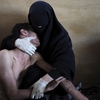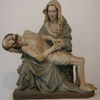The Problem with Western Press Photo
This World Press Photo of the Year 2011 was taken by Samuel Aranda. There are many categories and as many winners, but there is only one big winner, and Aranda’s photo it was. A post on the New York Times’ Lens blog noted that the image “has the mood of a Renaissance painting” - which, of course, is true. And that’s exactly one of the problems here. Jim Johnson already noted that the image in fact does not just reference Renaissance paintings in general. It assimilates Christian iconography (which was produced before and after the Renaissance as well): The Pietà, “depicting the Virgin Mary cradling the dead body of Jesus” (I’m including just a few examples in this post). If you have followed the news over the past decade even just tangentially, you might realize that using a visual language that could not be more Christian to depict an event in a Muslim country might pose a problem. (more; updated below)
These kinds of debates always center on photographs, though, and I think that that’s a problem. As a photograph, Aranda’s image is rather successful. As I said, it mixes Christian iconography with an event in a Muslim country, thus hinting at what should be obvious: Human suffering is independent of religion. But that doesn’t mean that this photograph should be used to illustrate the news, unless efforts are made to educate viewers what they’re actually looking at (there’s much more than “the mood of a Renaissance painting”!).
A viewer has to not only be aware of the iconography behind the image, s/he also has to understand how it was possibly used here to send a message. These kinds of nuances, however, are alien to the world of the news in the 21st Century. Instead, what we typically see in the news are world events seen from our - usually limited - perspective.
Take, for example, Tim Hetherington’s photo of a tired soldier: This is not a photograph about Afghanistan. It’s not a photo about the situation there, it doesn’t say anything about the suffering of people there. Instead, it focuses on a soldier from the West, and the photograph expresses what we all feel: We’re tired of that war (without really understanding what’s going on there).
If you look through the series of winning photographs of World Press Photo (I’m talking about the main winning image here, not the many others in the various categories), pretty much every photograph expresses something very specifically seen through our, Western, eyes. Photographers, of course, do their best to take good photographs. But what we see in the news, in newspapers, magazines, and on websites, is a carefully selected number of photographs conforming to usually very specific messages.
This is not to say that all media are biased (even though in reality many are), but that they are produced from a very specific background, usually our Western one. And it is that background we see reflected in World Press Photo. If we called it Western Press Photo the name would be a bit more accurate.
The World Press Photo 11 gallery says that 5,691 photographers of 125 nationalities submitted work. Doesn’t that show that I’m wrong, that it is in fact a World Press Photo? No, it doesn’t. As I said above, photographs in the news were first taken - by an obviously international group of people. But then they were selected/edited, and that typically involves a small number of people from an even smaller number of countries. You just have to go to, say, Al Jazeera’s website to often see very different images (of course, the narrative here is that they are biased).
So we have a problem, a problem that has actually increased over the past few years. We have seen a great many photographers going to remote places, taking photographs. We have seen the news media, especially online, using more and more images to present events. But we have not seen any efforts to use these images to educate viewers what they are actually looking at. For this flood of images in the news to really make sense - to tell us more about the world - we need more context, we need better explanations, and we also need an increased visual literacy. We need to learn how to question images, to ask what we are actually looking at.
If we don’t get that then we’ll helplessly stare at all these images, to project what we already know onto them. Samuel Aranda’s photograph provides a good opportunity: It’s easy to see the veil, it’s easy to see the pose (the expression of human suffering and of compassion), it’s easy to see (or at least somewhat realize) the very specifically Western visual imagery. But it’s quite a bit harder to put all that together and to then find out what we are really looking at.
And you cannot focus just on one aspect. It’s just not that simple. You have to weigh all the different aspects and find out what your reading says: What does the image depict? What does it say about our own cultural and political background? To what extent do we something because we want to see it that way? In other words, to what extent are we using a photograph to illustrate your own belief system?
Unless we learn how to get beyond our simplistic readings of photography, we’ll simply be stuck with what we might as well call Western Press Photo. We won’t get closer to understanding all those events that we currently grasp only as one-dimensional labels, lacking all context (“The Arab Spring”). We will continue sending soldiers to foreign countries, not really understanding what’s going on there (despite all those photographers going there trying to tell us!), not really asking whether that makes sense, and then pushing those same soldiers to the margins once they come back home.
Update (13 Feb 2012): A few other takes on the photo/subject matter: An article from the Yemen Times, Michael Shaw’s take, Michel Puech’s take.
Update (17 Feb 2012): I got it all wrong - or so Jeremy Nicholl claims. The reasons? Well, first I’m not a press photographer. Second, I don’t claim “any special knowledge of Islam and the Arab world”. And third, Nicholl quotes various people from Yemen who love the photo and the attention it got.
Where to begin? So maybe just in order. First of all, we simply can’t leave it to press photographers to talk about images. We all have a vested interest in the press doing their job properly, and that involves accountability. The idea that non-photographers are not allowed to criticize photographs is patently absurd.
Second, it is true that I don’t claim “any special knowledge of Islam and the Arab world.” But you don’t have to be a specialist in Islam or the Arab world to be aware of the huge amount of problems that have existed between the Arab world and the West, say, over the past decade alone: Remember the Iraq war? George W. Bush’s talk of a “crusade” against terrorism? The Danish cartoonist being threatened with death for exercising his democratic rights?
Lastly, I certainly appreciate people from Yemen enjoying the photograph. I can also relate to all those in the West who have praised the photograph for their emotional content. But here’s the problem: It’s a press photograph, and press photographs are not necessarily intended to make people feel good. The role of press photographs is to inform us about events in a news context.
Of course, picking just one photo of course always runs the risk of looking at a very small event in someone’s life. Inherently, the winning image will never be able to fill out that role. It’s too big for one photo.
Since Nicholl conveniently ignores the conclusion of my post, the main reason why I wrote this article, I’ll simply repeat it here: You cannot focus just on one aspect of a press photograph. It’s just not that simple. You have to weigh all the different aspects and find out what your reading says: What does the image depict? What does it say about our own cultural and political background? To what extent do we something because we want to see it that way? In other words, to what extent are we using a photograph to illustrate your own belief system?
We have to ask these questions because they are becoming ever more important. The internet (where a lot of the news reporting is happening these days) is filled with images, and for us to be able to gain a good understanding what is going on in the world we have to have visual literacy to question images and to look beyond their emotional content.
Thomas Jefferson’s words are more relevant than ever: “An informed citizenry is the only true repository of the public will.”




